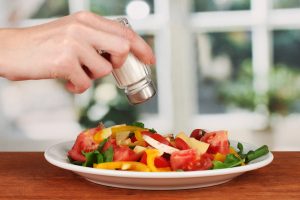
Recommended levels of sodium are now considered lower than what’s necessary, and the lower amounts are even linked to an increased risk of cardiovascular disease.
Sodium Guidelines Too Restrictive
New research, published in the American Journal of Hypertension, combined the results of 25 separate studies involving 275,000 participants.
Findings revealed that the sodium intake levels currently promoted by the Centers for Disease Control and Prevention (CDC) and other health organizations – less than 2,300 mg daily for healthy people under 50, and less than 1,500 mg for those over 50 – are actually too low and can lead to harmful health outcomes, such as cardiovascular diseases.
In fact, the average sodium intake of most Americans – 2,500 to 5,000 mg of sodium daily – is associated with better health results.
This might come as a surprise after years of eagle-eyeing sodium listings on food labels and banning the shaker from your dinner table.
But beware processed and fast-food choices, But beware processed and fast-food choices, and don’t forgo reading those nutrition labels. The average fast-food plain hamburger contains 378 mg of sodium. That’s 16 percent of a daily 2,300 mg limit. The average fast-food plain double-patty hamburger has 497 mg of sodium. (And most of us prefer our burgers with condiments, so that can mean more sodium.)
RELATED READING: Is There Plastic Is Your Fast-Food Sandwich?
Low Sodium Could Be Bad For Your Heart
The new findings support the Institute of Medicine’s earlier claim that lower levels of sodium in your diet could be harmful, increasing the likelihood of cardiovascular diseases. Certainly the incidence of heart disease – heart failure, arrhythmia (abnormal heart rhythm) and stroke – is still on the rise and recognized as the leading cause of death around the world.
But there is some good news: “Around 95 percent of the global population already consumes within the range we’ve found to generate the least instances of mortality and cardiovascular disease,” says the study’s lead author, Dr. Niels Graudal.
RELATED READING: Chocolate Pills For Your Heart, Oh My!
Tips For Managing Sodium Intake
In the meantime, continue to make wise choices in your diet. Don’t go full hog with the salt – processed foods and restaurant portions can contain far more sodium than your heart can handle. Try these steps to manage your overall sodium intake:
• Read the Nutrition Facts label to compare and find foods lower in sodium.
• Choose fresh fruits and vegetables whenever possible
• Be mindful of the amount of processed foods you eat and your portion size
• Learn to use spices and herbs to enhance the taste of your food; many spices naturally contain very small amounts of sodium
• Add fresh lemon juice instead of salt to fish and vegetables (a little salt won’t hurt, but lemon juice can be so fresh and tasty)
• Specify how you want your food prepared whenever you dine out. You can often ask for your dish to be prepared with less salt
• Choose foods with potassium; they counter the effects of sodium and may help to lower your blood pressure, too.
Here’s to smart choices and great eating!